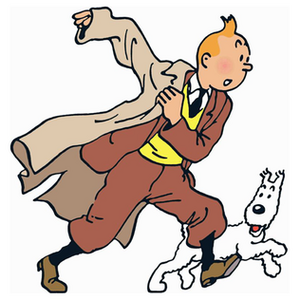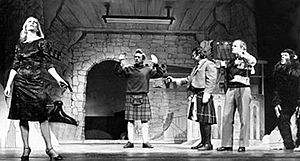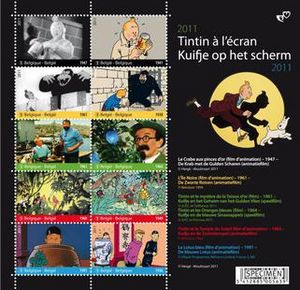The Adventures of Tintin facts for kids
Quick facts for kids The Adventures of Tintin |
|||
|---|---|---|---|
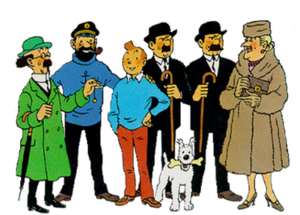
The main characters of The Adventures of Tintin from left to right:
Professor Calculus, Captain Haddock, Tintin, Thompson, Snowy (dog), Thomson, and Bianca Castafiore |
|||
| Created by | Hergé | ||
| Publication information | |||
| Publisher |
|
||
|
|||
| Formats | Original material for the series has been published as a strip in the comics anthology(s)
|
||
| Original language | French | ||
| Genre | Action/adventure | ||
| Publication date | 1929 – 1976 | ||
| Main character(s) |
|
||
| Creative team | |||
| Writer(s) | Hergé | ||
| Artist(s) |
|
||
| Colourist(s) |
|
||
The Adventures of Tintin (French: Les Aventures de Tintin) is a famous series of 24 comic books. They were created by a Belgian cartoonist named Georges Remi, who was known as Hergé. This series became one of the most popular European comics of the 20th century.
By 2007, over 200 million copies of Tintin books had been sold. They were published in more than 70 languages! The stories were also made into radio shows, TV shows, plays, and movies.
The first Tintin story appeared in French on January 10, 1929. It was in a newspaper supplement for young people called Le Petit Vingtième (The Little Twentieth). Because the series was so popular, new stories were printed in a major Belgian newspaper, Le Soir (The Evening). Later, a successful Tintin magazine was also created. In 1950, Hergé started Studios Hergé to produce the official versions of 11 Tintin books.
The series takes place in a realistic 20th-century world. The main character is Tintin, a brave young Belgian reporter and adventurer. He is always helped by his loyal dog, Snowy (called Milou in French). Other friends include the grumpy but kind Captain Haddock, the smart but hard-of-hearing Professor Calculus, and the funny detectives Thomson and Thompson. There's also the opera singer Bianca Castafiore.
People love the series for its clear and expressive drawings, a style called ligne claire ("clear line"). The stories are well-researched and mix action-adventure with mystery. They touch on themes like history and technology, often with funny moments.
The stories combine different styles, including adventure and humor. Twenty-three complete books were published between 1929 and 1976. A 24th story, Tintin in Alph-Art, was never finished because Hergé passed away in 1983.
Contents
Meet the Characters
Tintin and Snowy
Tintin is a young Belgian reporter and adventurer. He often gets involved in dangerous situations. He always acts heroically to save the day. Even though he's a reporter, you rarely see him actually writing a story!
Readers describe Tintin as a smart and creative character. He doesn't have a detailed background story, which lets readers imagine themselves in his place. Tintin always sticks to his good ideals. His simple design helps readers feel like they are part of his exciting world.
Snowy (Milou in French) is Tintin's loyal white Wire Fox Terrier dog. He is always by Tintin's side. Snowy is also afraid of spiders!
Captain Haddock
Captain Archibald Haddock (Capitaine Haddock in French) is a sea captain and Tintin's best friend. He first appeared in The Crab with the Golden Claws. At first, he seemed a bit weak, but he grew into a truly brave character. He even became wealthy after finding treasure from his ancestor, Sir Francis Haddock.
Captain Haddock is often grumpy and uses funny, colorful insults like "billions of bilious blue blistering barnacles!" He balances Tintin's sometimes too-perfect heroism with his down-to-earth personality.
Professor Calculus
Professor Cuthbert Calculus (Professeur Tryphon Tournesol in French) is a brilliant physicist. He is a bit forgetful and hard of hearing. He is a regular character along with Tintin, Snowy, and Captain Haddock. He was first seen in Red Rackham's Treasure. His character was partly based on a real Swiss physicist, Auguste Piccard.
Other Friends and Foes
Hergé's other characters are very well-developed. They have strong personalities and add a lot of depth to the stories. Hergé used these characters to create a realistic world for Tintin's adventures. Many characters appear again and again throughout the series, making the world feel continuous.
Thomson and Thompson (Dupont et Dupond in French) are two detectives who look like identical twins. The only way to tell them apart is by the shape of their moustaches! They first appeared in Cigars of the Pharaoh. They are very clumsy and often mix up their words. They usually wear bowler hats and carry walking sticks. When they travel abroad, they try to wear local clothes, but they always end up looking very out of place!
Bianca Castafiore is an opera singer that Captain Haddock is terrified of. She first appeared in King Ottokar's Sceptre. She seems to show up wherever Tintin and his friends go, along with her maid Irma and pianist Igor Wagner. She is friendly but also a bit silly and talks a lot. She doesn't seem to realize that her singing voice is very loud! Her favorite song is the Jewel Song from the opera Faust. She often mixes up names, calling Haddock things like "Paddock" or "Hopscotch."
Other characters who appear often include:
- Nestor, the butler.
- Chang, a loyal Chinese boy.
- Rastapopoulos, a criminal mastermind.
- Jolyon Wagg, an annoying insurance salesman.
- General Alcazar, a South American leader.
- Mohammed Ben Kalish Ezab, an Arab emir, and his mischievous son Abdullah.
- Dr. Müller, an evil German doctor.
- Oliveira da Figueira, a friendly Portuguese salesman.
- Cutts the butcher, whose phone number is always confused with Haddock's.
- Allan, a bad guy who works for Rastapopoulos.
Story Locations
The places where Tintin stories happen make the comics even more interesting. Hergé used a mix of real and made-up places. In King Ottokar's Sceptre, he created two fictional countries, Syldavia and Borduria. Readers even get to see a travel brochure for them in the story! Other made-up lands include Khemed in the Arabian Peninsula and San Theodoros in South America.
Besides these fictional places, Tintin also visits many real locations. These include Switzerland, the United Kingdom, the United States, Peru, India, Egypt, China, and even the Moon!
Tintin in Other Media
The Adventures of Tintin has been made into many different forms, not just comic books. Hergé himself supported these adaptations. After Hergé passed away in 1983, the Hergé Foundation and Moulinsart (which handles copyrights) became responsible for allowing new adaptations.
TV and Radio Shows
Two animated TV series and one radio series have been made.
Hergé's Adventures of Tintin (1957) was the first TV show. Ten of Hergé's books were made into short, five-minute episodes. The stories in this series were often quite different from the original books.
The Adventures of Tintin (1991–92) was a more popular TV series. It adapted twenty-one Tintin books and stuck very closely to the original comics. This series was shown in over fifty countries and is available on DVD.
A radio series called The Adventures of Tintin (1992–93) was produced by BBC Radio 5. These radio plays featured actors like Richard Pearce as Tintin and Andrew Sachs as Snowy.
Movies
Six feature-length Tintin films have been made. Five were made before Hergé's death in 1983, and one more in 2011.
The Crab with the Golden Claws (1947) was the first movie based on a Tintin comic. It was a stop-motion puppet film made by a small Belgian studio.
Two live-action Tintin films were made: Tintin and the Golden Fleece (1961) and Tintin and the Blue Oranges (1964). These movies had new stories not found in Hergé's books.
Tintin and the Temple of the Sun (1969) was the first full-length animated Tintin film. It combined two books: The Seven Crystal Balls and Prisoners of the Sun. Tintin and the Lake of Sharks (1972) was the second animated film, also with an original story.
The Adventures of Tintin: The Secret of the Unicorn (2011) was a 3D animated film directed by Steven Spielberg. It was based on three of Hergé's books: The Crab with the Golden Claws, The Secret of the Unicorn, and Red Rackham's Treasure. The movie received good reviews and was very successful.
Plays
Hergé himself helped create two stage plays in the 1940s. These plays were performed in Brussels.
In the late 1970s and early 1980s, two Tintin plays were performed in London. These were Tintin's Great American Adventure and Tintin and the Black Island.
A musical based on The Seven Crystal Balls and Prisoners of the Sun opened in Belgium in 2001. It was called Tintin – Temple of the Sun (The Musical).
In 2005–2006, a musical version of Tintin in Tibet was performed in London. This show was very popular and toured again in 2006–2007 to celebrate 100 years since Hergé's birth.
Video Games
Tintin has also appeared in many video games:
- Tintin on the Moon (1989)
- Tintin in Tibet (1995)
- Prisoners of the Sun (1996)
- Tintin: Destination Adventure (2001)
- The Adventures of Tintin: The Secret of the Unicorn (2011), based on the movie.
- Tintin Match (2020), a mobile game.
- Tintin Reporter: Cigars of the Pharaoh (2023).
Collectibles and Shops
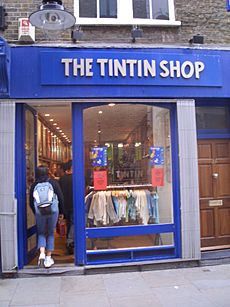
Images from the Tintin series have been used on many different products for a long time. There have been countless items related to Tintin, from alarm clocks to clothing. Some of these items have become valuable collector's items.
The Hergé Foundation carefully controls who can use Tintin's image. They want to make sure Tintin remains popular and special.
There are even shops dedicated only to Tintin! The first one opened in 1984 in London. Tintin shops can also be found in Belgium, France, and the Philippines.
Stamps and Coins
Tintin's image has appeared on postage stamps many times. The first Tintin stamp was issued by Belgian Post in 1979 to celebrate 50 years of Tintin's adventures. In 1999, a set of stamps celebrated the Belgian Comic Strip Center, featuring Tintin's famous Moon rocket. More stamps were issued in 2001 and 2004, often celebrating anniversaries of the books or space exploration. In 2007, to celebrate 100 years since Hergé's birth, Belgian Post released a sheet of 25 stamps showing all 24 Tintin album covers.
Tintin has also been featured on coins. In 1995, the Paris Mint issued a set of gold medallions. A silver medallion was minted in 2004 for the 50th anniversary of the Explorers on the Moon book. In 2004, Belgium minted a special €10 euro coin featuring Tintin and Snowy to celebrate 75 years of Tintin's adventures. From 2006 to 2012, France issued a series of coins honoring famous comics, starting with Tintin. These included several euro coins featuring Tintin, Snowy, and his friends.
See also
 In Spanish: Las aventuras de Tintín para niños
In Spanish: Las aventuras de Tintín para niños


